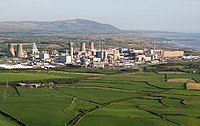
Photo from wikipedia
Owing to its lack of crosslinking, polypropylene (PP) is considered an environmentally friendly alternative to crosslinked polyethylene as high-voltage direct current (HVDC) cable insulation. However, pure PP can accumulate space… Click to show full abstract
Owing to its lack of crosslinking, polypropylene (PP) is considered an environmentally friendly alternative to crosslinked polyethylene as high-voltage direct current (HVDC) cable insulation. However, pure PP can accumulate space charges under a HVDC, and thus must be modified for use as an insulating material for HVDC cables. In this study, 4-methylstyrene is grafted onto PP using an aqueous suspension grafting method to improve its properties. The effects of the swelling time, reaction time, and 4-methylphenylene concentration on the reaction were investigated. The optimum process conditions were determined, including an optimum grafting ratio of 0.97%. The volume resistivity, ability to suppress space-charge accumulation, and DC breakdown strength of modified PP were also studied. Modified PP with a grafting ratio of 0.88% showed optimal space-charge suppression and the highest volume resistivity and breakdown strength. The work will facilitate the design and development of more efficient insulation materials for HVDC cables.
Journal Title: Materials
Year Published: 2022
Link to full text (if available)
Share on Social Media: Sign Up to like & get
recommendations!